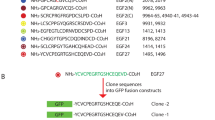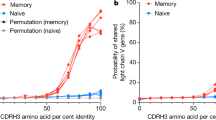Abstract
THE origin of the diversity of antibody combining sites is one of the crucial questions of immunology. Many workers, hoping for evidence from structural studies of homogeneous antibodies, have attempted to elicit antibodies with restricted heterogeneity1–6. Another approach to the problem is to study the ontogeny of antibody diversity7–10. These and other approaches have been hindered by inadequate criteria for judging antibody heterogeneity. Techniques for the direct analysis of isoelectric heterogeneity of specific antibodies (A. R. W., in preparation) have facilitated the search for homogeneous antibodies and made it possible to study developmental aspects of diversity. These two approaches are combined in the studies we report here on the anti-hapten antibodies produced by neonatal rabbits. We have found that in the initial response to a heterogeneous presentation of hapten, neonatal rabbits frequently produce anti-hapten antibodies with restricted isoelectric spectra. The term “restricted” is used relative to the spectra of antibodies produced in adult animals. In certain neonates, the antibody spectrum resembled that characteristic of a single clone (monoclonal antibody).
This is a preview of subscription content, access via your institution
Access options
Subscribe to this journal
Receive 51 print issues and online access
$199.00 per year
only $3.90 per issue
Buy this article
- Purchase on Springer Link
- Instant access to full article PDF
Prices may be subject to local taxes which are calculated during checkout
Similar content being viewed by others
References
Brenneman, L., and Singer, S. J., Proc. US Nat. Acad. Sci., 60, 258 (1968).
Eichmann, K., Lackland, H., Hood, L., and Krause, R. M., J. Exp. Med., 131, 207 (1970).
Klinman, N. R., Immunochemistry, 6, 757 (1969).
Haber, E., Fed. Proc., 29, 66 (1970).
Haber, E., Richards, F. F., Spragg, J., Austen, K. F., Valotton, M., and Page, L. B., Cold Spring Harbor Symp. Quant. Biol., 32, 299 (1967).
Wu, W-H., and Rockey, J. H., Biochemistry, 8, 2719 (1969).
Bellanti, J. A., Eitzman, D. V., Robbins, J. B., and Smith, R. T., J. Exp. Med., 117, 479 (1963).
Wainer, A., Robbins, J. B., Bellanti, J. A., Eitzman, D. V., and Smith, R. T., Nature, 198, 487 (1963).
Sterzl, J., and Silverstein, A. M., Adv. Immunol., 6, 337 (1967).
Cotes, P. M., Hobbs, K. R., and Bangham, D. R., Immunology, 11, 185 (1966).
Awdeh, Z. L., Williamson, A. R., and Askonas, B. A., Nature, 219, 66 (1968).
Stupp, Y., Yoshida, T., and Paul, W. E., J. Immunol., 103, 625 (1969).
Awdeh, Z. L., Askonas, B. A., and Williamson, A. R., Biochem. J., 102, 548 (1967).
MacDonald, A. B., Alescio, L., and Nisonoff, A., Biochemistry, 8, 3109 (1969).
Oudin, J., and Michel, M., J. Exp. Med., 130, 619 (1969).
Askonas, B. A., Williamson, A. R., and Wright, B. E. G., Proc. US Nat. Acad. Sci., 67, 1389 (1970).
Author information
Authors and Affiliations
Rights and permissions
About this article
Cite this article
MONTGOMERY, P., WILLIAMSON, A. Molecular Restriction of Anti-hapten Antibody elicited in Neonatal Rabbits. Nature 228, 1306–1308 (1970). https://doi.org/10.1038/2281306a0
Received:
Issue Date:
DOI: https://doi.org/10.1038/2281306a0
This article is cited by
-
Isoelectric focusing of proteins in gels
Chemistry of Natural Compounds (1973)
Comments
By submitting a comment you agree to abide by our Terms and Community Guidelines. If you find something abusive or that does not comply with our terms or guidelines please flag it as inappropriate.



